Pop-Up Shabbat is a pop-up restaurant inspired by Jewish culture and tradition in Brooklyn, NY. Each gathering lasts 3-4 hours and includes mingling, family-style dining, music, sometimes dancing, and a bit of Shabbat tradition.
Partnerships with local institutions such as Brooklyn Brewery and Fleischman’s butchery assured a delicious menu, and tickets purchased in advance, ensure financial sustainability. Using tickets or other kinds of pay-for-services models is fairly uncommon in North American congregations, but all congregations have to figure out some kind of structure or system for ensuring it has the resources needed. New forms of gathering require new models of funding.
Founder Danya Cheskis-Gold had grown away from her Orthodox Jewish upbringing but was looking to maintain a relationship with her tradition. She explained, “I joined the board of a Jewish nonprofit, and I tried out hippie synagogues in Park Slope and matchmaking ones on the Upper West Side. But I loved my potluck Shabbat dinners the most. Friends, food, fun.” Though Pop-Up Shabbat is clearly Jewish, it doesn’t draw a boundary on participation or belonging. Cheskis-Gold was so focused on openness that she was surprised by the desire of guests to connect to tradition. On the first gathering, she had simply planned delicious food on a Friday night with some conversation about rest and renewal, a broad Shabbat theme. Instead, she says, “half-way through the dinner, someone asked when we were going to bless the candles and the wine and everyone joined in to demand a blessing! I hadn’t expected that at all, but it’s now a staple of every meal.”
“Although Pop-Up Shabbat is clearly Jewish, it doesn’t draw a boundary on participation or belonging. Cheskis-Gold was so focused on openness that she was surprised by the desire of guests to connect to tradition.”
The community has no formal relationship to a Synagogue, denomination or Rabbi. This was a conscious choice for Cheskis-Gold, who wanted Pop-Up Shabbat to be a place where all felt welcome and there was no need for participants to commit theologically. But the idea was so popular that organizations like the United Jewish Federation have adopted it and spread it beyond Brooklyn.
These sorts of broader trends in society are a key part of every congregation’s ecology. More young adults are declaring that they have no religious affiliation or preference – they are ‘nones.’ While some young unaffiliates may become more religious as they grow older, they show every sign of being rather stable in their non-religious lives. With over half of their generational compatriots attending religious services yearly or less, they do not live in a world that pushes them toward affiliation the way 1950s baby boom families were pushed toward congregational doors. But the desire for tradition is worthy of note. Too often, religious leaders look toward the new to attract younger participants, when it may be traditional practices embedded in modern settings that draw in newcomers. It’s worth thinking about where a congregation’s culture is inviting and where it may not be.

